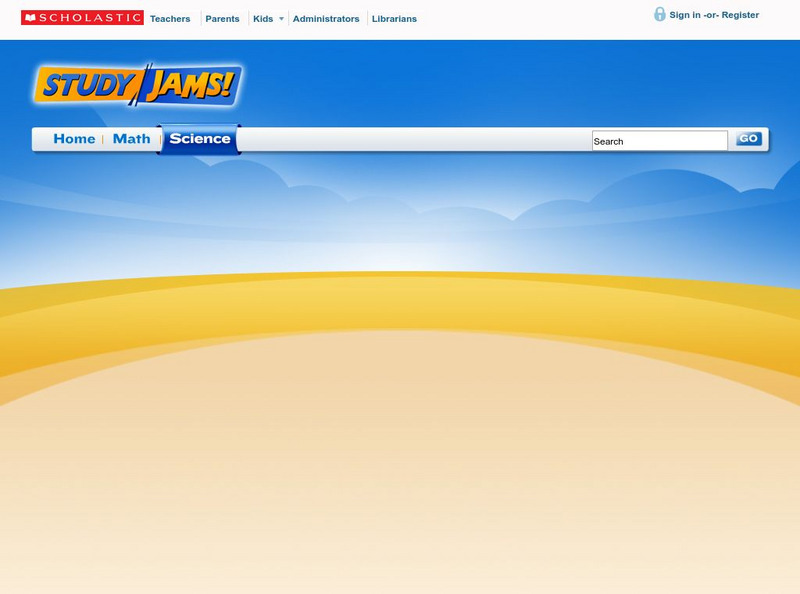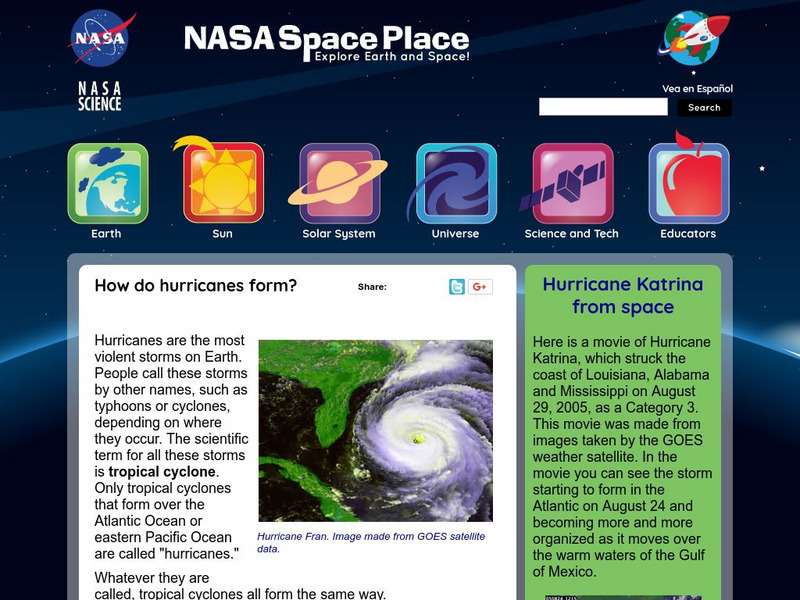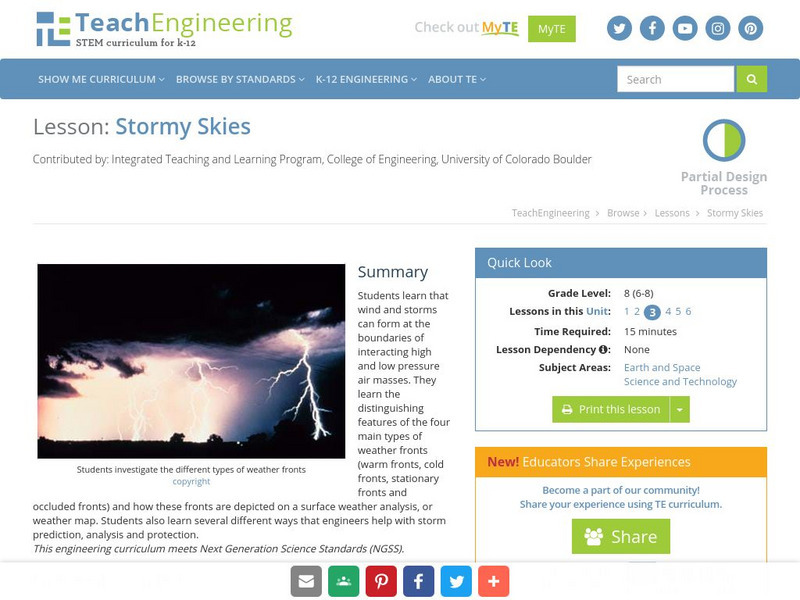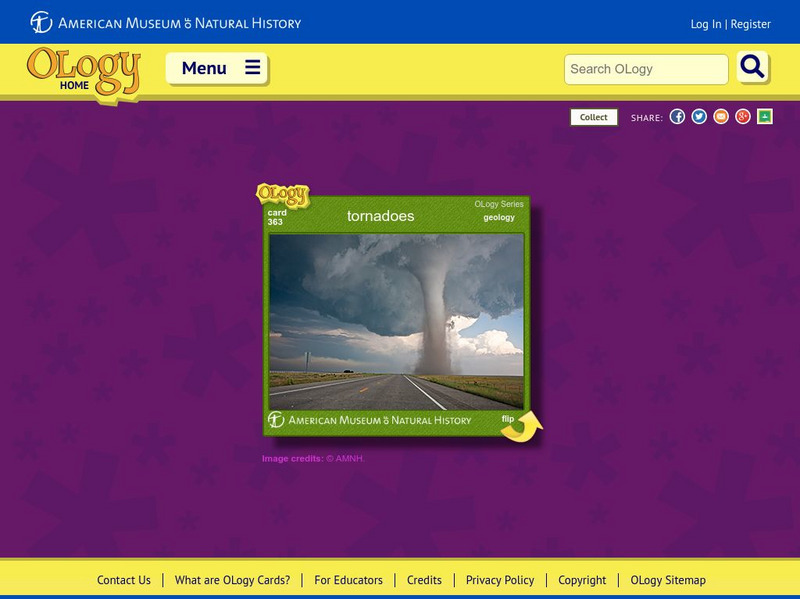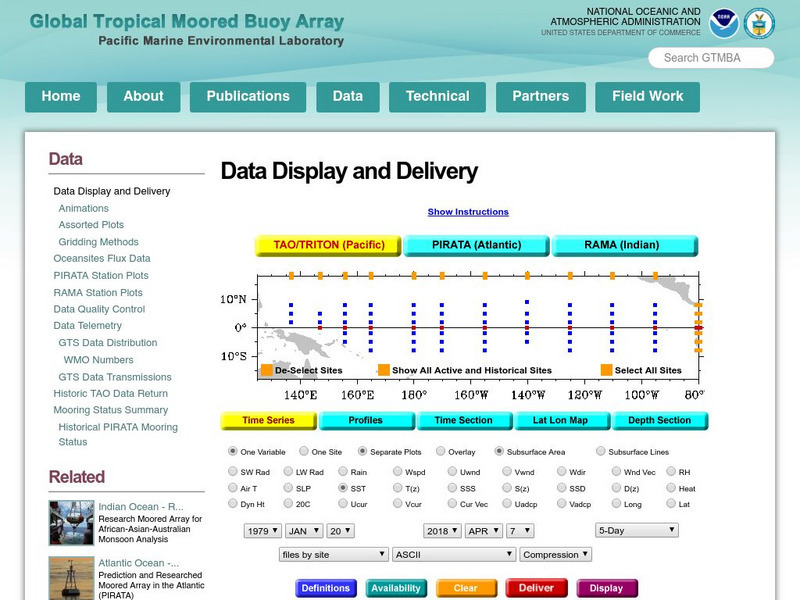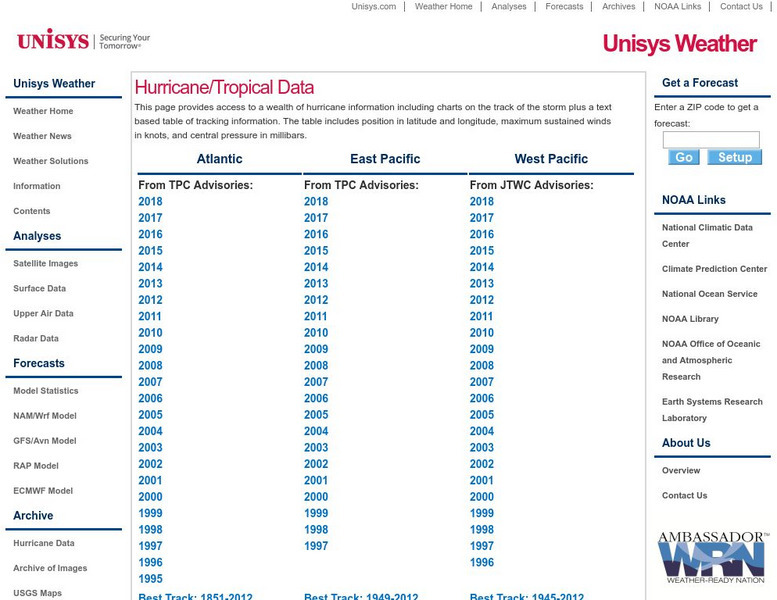Hi, what do you want to do?
Scholastic
Scholastic: Study Jams! Science: Weather & Climate: Severe Storms
A slideshow and a short multiple-choice quiz on the topic of severe storms, some types, and the damage that they cause.
National Geographic
National Geographic: Extreme Weather on Our Planet
This lesson from National Geographic for grades 2-5 has a great photo gallery and video of extreme weather, and a chart for plotting weather investigation. Learning objectives, teaching methods, and connections to National Science...
Science Education Resource Center at Carleton College
Serc: Drought
Eight online learning labs which focus on the effects of drought, the quiet disaster. Each module takes students to external sites containing data, graphs, and articles. Several labs also require additional software programs: a...
NASA
Nasa: Hurricanes
Learn about hurricanes and how they are created. Features include video animation, the histories of the most devastating hurricanes and topics such as hurricane naming and hurricane study.
NASA
Nasa: The Space Place: How Do Hurricanes Form?
This resource explores how hurricanes form and why they are called tropical cyclones. Images and illustrations are provided supporting this information.
CPALMS
Florida State University Cpalms: Florida Students: Natural Disasters
Enrich studying natural disasters like hurricanes and tornadoes. Know how to identify several types of natural disasters that occur in Florida, and describe how these disasters can affect people living there.
University of Wisconsin
The Why Files: Control a Tornado? Absolutely!
Control a tornado's intensity by manipulating its width and rotation speed.
TeachEngineering
Teach Engineering: Tornado!
Learners learn about tornadoes - their basic characteristics, damage and occurrences. Students are introduced to the ways that engineers consider strong winds, specifically tornadoes, in their design of structures. Also, learners learn...
TeachEngineering
Teach Engineering: Stormy Skies
Learners learn that wind and storms can form at the boundaries of interacting high and low pressure air masses. They learn the distinguishing features of the four main types of weather fronts (warm fronts, cold fronts, stationary fronts...
CK-12 Foundation
Ck 12: Earth Science: Hurricanes
[Free Registration/Login may be required to access all resource tools.] Describes how a hurricane forms and its effects.
American Museum of Natural History
American Museum of Natural History: Tornadoes O Logy Card
Flip this interactive card to start learning about tornadoes, nature's most powerful storms. Answer multiple-choice and fact-or-fiction questions and review some fast facts about tornadoes.
NASA
Nasa: Sci Jinks: What's a Derecho?
Learn how the strong winds from a devastating storm called a derecho are different than the winds from a tornado. Discover how big a derecho can be and where they most likely occur.
NOAA
Noaa: Pmel: Tropical Atmosphere Ocean Project: Tao/triton Data Display
Resource features real-time data from moored ocean buoys for improved detection, understanding, and prediction of El Nino and La Nina with diagrams.
PBS
Pbs Nova: Killer Tornado of 1928
This resource provides a remarkable first-hand account of the day a tornado struck a small town in Nebraska in 1928 taking lives, injurying many, and causing much devastaion.
NOAA
Noaa: Nssl: Weather Colouring Books
Print these free colouring books about tornadoes, thunderstorms and winter weather.
Weather Wiz Kids
Weather Wiz Kids: Weather Safety
Click on the links to find guides to weather and natural disaster safety tips for earthquakes, floods, heat waves, hurricanes, lightning, mudslides, avalanches, thunderstorms, tornadoes, tsunamis, volcanoes, wildfires, and winter storms.
Other
Unisys: Hurricanes/tropical Data
There is a table that has links to hurricanes in the Atlantic from 1995, East Pacific from 1997, West Pacific from 1996, South Pacific from 2000, and South India from 2000. This page has a satellite map and the Saffir-Simpson Scale.
NOAA
Noaa: Storm Prediction Center
Get real time data on storms across the nation that have occurred over the past 24 hours. The data includes storm locations, severity and brief damage reports.
American Geosciences Institute
American Geosciences Institute: Earth Science Week: Dangerous Atmosphere
For this activity, students research what types of severe weather their county has had over the past 50-60 years. They will look at the severity of these events and the number of injuries and deaths they caused. They will then decide...
Other
K 3 Learning Pages: Web Resources Thunderstorms
Check out this comprehensive list of web resources on thunderstorms and safety. Students and teachers will benefit from the links found on this site.
Teachers.net
Teachers.net Lesson: Natural Disaster Bloom's Taxonomy
Here is a lengthy activity for student to work on while learning about floods, hurricanes, tornadoes, and earthquakes. Students will enjoy researching these disasters and applying what they have learned to a project.
American Geosciences Institute
American Geosciences Institute: Earth Science Week: Hurricane Tracking
Students track and plot hurricanes paths for study.
Science Struck
Science Struck: Famous Hurricanes of the World
Describes famous hurricanes that have struck in the Northern Hemisphere since 1900, the regions affected, the intensity of the storms, and the extent of damage each caused. The hurricanes are organized in sequential order.
Science Struck
Science Struck: Different Types of Storms
Provides descriptions of a variety of storm types including wintry ones, ones with no precipitation, and very destructive ones. Discusses weather conditions that lead to these storms, precautions one can take, public alerts, etc.





